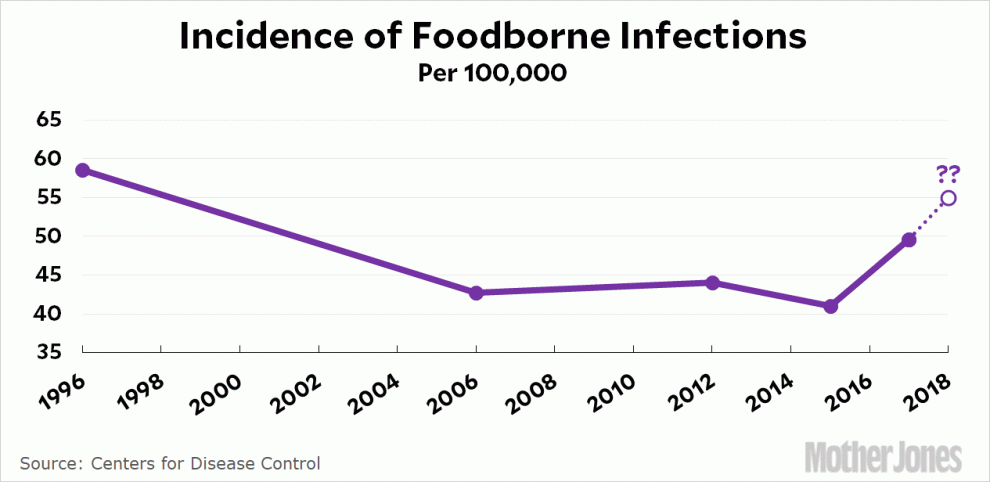
There have been a bunch of food scares this year, culiminating in a warning of E. coli in romaine lettuce announced last week—the second one in 2018. So what’s going on? Is our food getting worse? Jack Denton of Pacific Standard says, not really:
When there’s an increase in outbreaks without a rise in individual illnesses, it means that technology and epidemiologists have gotten better at identifying why people are getting sick—that more illnesses which might have been considered sporadic in past years are now successfully linked to a common source. And the CDC’s latest available charting of foodborne illness rates shows that they are not on the rise in the U.S. Between 2008 and 2015, E. coli infections dropped by 30 percent, and most foodborne illnesses saw no change.
Accordingly, any increase in identified outbreaks is good, likely the result of two major technological changes in roughly the last two decades that have led to scores more outbreaks being successfully identified. In 1996, the CDC began using Pulsenet, a system that tracks foodborne illnesses across the country by comparing the DNA fingerprint of discovered pathogens to see if they are similar….Starting in 2008, the public-health community began using a new method of DNA fingerprinting called whole genome sequencing, which has led to a large spike in detected outbreaks. “I get leery because I don’t think we can compare pre-2008 to today, because we measure things differently,” Chapman says. “We’re getting better at detecting the outbreaks, and there are better-trained public-health individuals now looking to solve foodborne illness outbreaks than we’ve ever had.”
This got me curious, but it turns out the CDC makes it surprisingly difficult to find and summarize annual outbreaks of foodborne illnesses. But not impossible! Assuming I copied the numbers correctly and then did the arithmetic right, here’s the overall incidence of foodborne illnesses in the US since 1996:

E. coli may be down between 2008 and 2015, but overall foodborne illnesses spiked upward in 2017, and that’s using the same new technology the CDC put in place in 2008. Numbers for 2018 aren’t available yet, so we don’t know if things have gotten even worse since the 2017 spike.
In any case, I’m not really sure why we put up with this. I’ve probably mentioned this before, but a big part of the answer to food poisoning is simple: irradiation. It’s simple, safe, and it’s old technology with years of use behind it. It won’t do anything for foodborne illnesses introduced during prep—Chipotle can’t run your tacos through an irraditation machine on the way to the cash register—but it would be a boon to the packaged food industry. For all practical purposes, if it were made mandatory it would entirely eliminate foodborne illnesses in raw commercial and packaged foods.
But it’s opposed by conservatives because it’s a regulation that would save lives, and who wants that? And to make things worse, it’s also opposed by many liberals, who view it as a Frankenfood sort of thing that would destroy their precious organic labels. In fact, it would do no such thing. It doesn’t leave any radiation behind, it doesn’t kill off vitamins, and it doesn’t affect the taste of food. It just kills off pathogens, the same as pasteurizing milk.
Why, even lefty rags like Mother Jones think it’s a good idea. You can read all about it here.
NOTE: The CDC monitors all reported foodborne infections in a surveillance area that includes ten states. These states are hopefully representative of the whole nation, but you never know. For that reason, the numbers in the chart have a higher uncertainty than usual.
Also, there are far more cases of foodborne infection that are never reported. This includes the 24-hour bugs and so forth that we all get but never bother seeing a doctor about. CDC estimates the total number of foodborne illnesses in the US at about 50 million per year.








